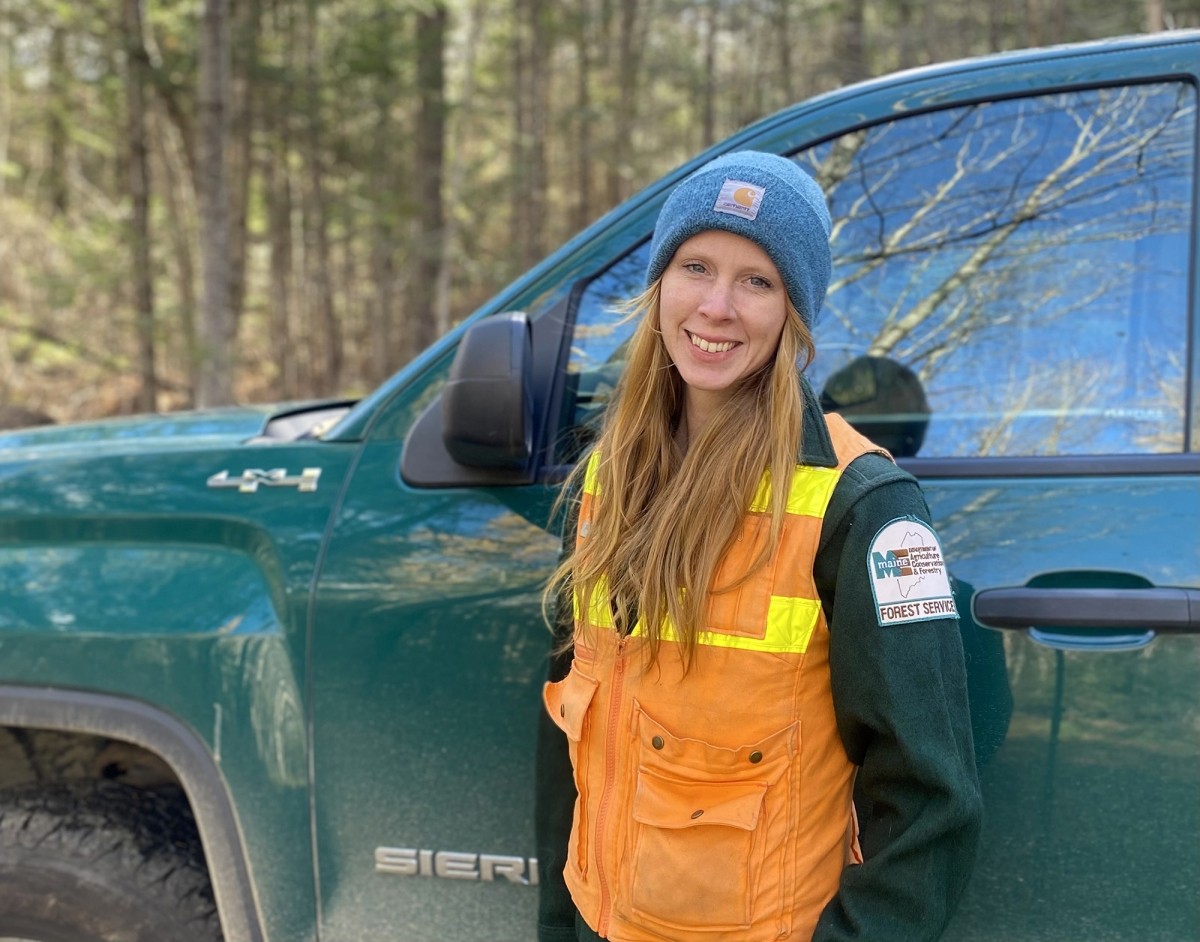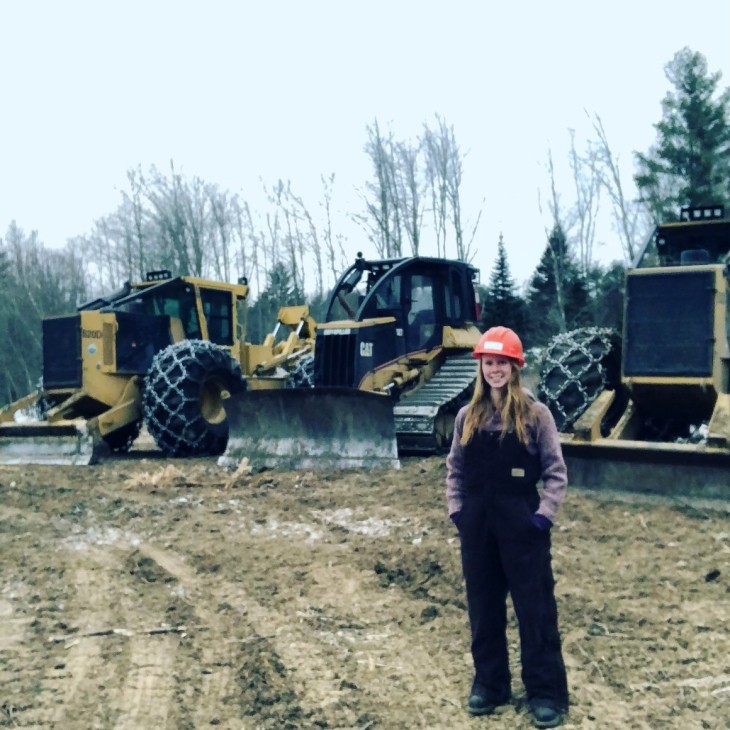
Julie Davenport is a district forester with the Maine Forest Service. In this role, she serves about 80 towns and provides educational resources and technical assistance to landowners, loggers, schools, towns, and other stakeholders, enforces state regulations, and completes routine natural resource monitoring. Julie is a lifelong Mainer and graduated from University of Maine with a degree in forestry in 2015. When she’s not on the job or in the woods, Julie enjoys spending time with family, a hot cup of tea, and working on a knitting or sewing project.
I grew up in central Maine in a small town called Fayette. Now I live two towns over, so I like to joke that I didn’t make it very far. Growing up I was not super outdoorsy, but my parents were into gardening, so I spent time doing that with them. My dad is a forester, although I was never out with him. I didn’t even really know what he did; I just knew he drove a pickup truck and there was blue paint all over everything, and he seemed like he was happy.
In high school I got more into spending time outside and started to go hiking. I felt better and healthier. I was really into horses, and if I had free time, I wanted to be in the woods riding horses. At the end of high school, after I had been outside on a beautiful May afternoon I came in and I told my dad, “Hey, I think maybe I would like to be a forester, too.” He kind of looked at me and put his fork down and said, “I don’t really think that’s for you.” We talked about other jobs I could do – I really liked camping and so I thought I might want to be a park ranger.
University of Maine had a degree in parks, recreation, and tourism, and so I headed there in 2011. I wanted to work at Baxter State Park. In my first semester, I had a lot of classes with the forestry kids, and they were doing a lot cooler things. Their other classes just seemed more interesting to me. I realized I could still be a park ranger with a forestry degree, but I couldn’t be a forester as easily with a parks and rec degree, so I switched my major.
Everyone did internships with big landowning companies back then – places like Plum Creek, Seven Islands, American Forest Management – where you’d do summer work in remote areas on these big industrial land bases. Even then, I knew that wasn’t for me. I wanted to live closer to where I grew up and work with people. One of my professors put me in contact with the Insect and Disease Lab at the Maine Forest Service about a summer internship. I was afraid of bugs growing up, so it was a complete 180. I did a lot of work with invasive pests and diseases there. I worked there for a few summers in a row, and I really liked the Maine Forest Service and met some of the district foresters. I had stars in my eyes meeting them. I thought it was the dream job. I shadowed a few, but there aren’t many district forester positions, and people tend to stay in them a long time, so that wasn’t an option for me right away.
In Maine, if you get a forestry degree from an SAF-accredited school, you just need to do a two-year internship and take the Maine specific exam to get your forester license. My first full-time job was at Sappi, a paper mill in Skowhegan. My role was as a forest technician in the landowner assistance program. I did most of the in-woods tasks to keep the harvests going and hung a lot of flagging. I never really thought I’d be into big equipment, but as spent more time around it, I realized how much I like harvest operations. After I passed my test and had my license, I moved up, and my role covered the whole process of small woodlot management for private landowners: meeting people, writing management plans, and setting up and overseeing timber harvests, all while making sure we cut enough wood to keep the mill happy. It could be really rewarding when things went well, but I also felt like it didn’t necessarily play into my skill set. I liked working with landowners and talking to them but didn’t want my work to be as fast paced and high stress anymore.
A district forester job opened up, and now I’ve been in the role for over six years. My number one responsibility is to be available as a resource for anyone who has a connection to trees or forests: landowners, loggers, schools. The bread-and-butter of the role is a “walk and talk,” which is a free – or really, tax-paid – service, where we go out on someone’s property and walk their land with them and talk about what their goals are, how they can manage their forest to hit those goals, and what is or isn’t feasible. I don’t oversee any harvests or write any management plans in my role as a district forester, but I connect landowners with foresters who I think will be a good fit for their goals and personalities.
There’s a lot of new landowners in Maine, especially since COVID. I wish more people knew district foresters were a resource when they acquired or inherited land, and that at any point, they can call their district forester to set up a free visit just to talk about what’s important to them and how to manage for that specifically. All landowner objectives are important: some people just want a quiet place to walk, or to be able to see this bird or that wildlife, and some people want to be able to harvest in 15 years to help a kid pay for college. Some want all three, or more. Visits are about figuring out priorities, and not that any are necessarily better or worse than others. It’s great that there are people who don’t want to cut a single tree and that there are people who want to do intensive timber harvesting; managing for your own objectives and letting others follow theirs is what makes things balanced and what works on the landscape level.
I do a lot of education with schools and adult education programs, presenting on different topics. And another facet of my work is enforcing state rules for water quality, clearcutting, and harvesting regulations. I try to work with people to figure out how they can avoid problems and stay out of trouble – that’s always the most desirable, but occasionally it involves pursuing remedial action after someone has done something wrong.
It’s very people-centered work; I work with hundreds of people. Our districts are interesting in that they’re divided by population density rather than actual area, so some of them are bigger than others. Every forester will tell you they have the best district, but I really believe that I have the best district. It’s a good mix of remote, industrial timber grounds and also a lot of smaller, very involved landowners in more populated areas. I enjoy that there are different challenges in different places. I have around 80 towns in my district, but as you might imagine, not a lot is happening in some of the unorganized townships where there aren’t as many people living there.
Every day is different, but the constant is that people always have questions about trees and forests. There isn’t a day that my phone doesn’t ring. Sometimes it’s somebody who says, “I have this tree in my yard, and all the needles fell off,” so I’ll look at it with them and try to figure out what’s wrong. Sometimes people call about a logging job down the road that they’re concerned about – sometimes there’s something wrong, and sometimes there isn’t. People seem to have a tough time with change, especially with the environment closest to them. I’m here to either answer things for them or connect them with someone else who can help.
It’s just human nature, but people have a tendency to think they have a deep understanding of something and make decisions based only on that, and find it difficult to take in new information or reassess their opinions. It can be hard to navigate sometimes. With timber harvests, a lot of people seem to assume that if they see cutting, something illegal is happening, especially if they don’t see replanting. I try to explain that, usually, timber harvesting is actually a good thing for the forest and that we’re really lucky in the Northeast to not need to replant. A lot of people are against forest management. One way I frame it is: forest management is like a haircut. You can have a good haircut or a bad haircut. You want to avoid getting a bad haircut, so you make sure you go to someone you trust and who knows about what they are doing.
Other times, I’ll meet with someone really excited to show me how involved they are in their forest and how they’ve picked up all the deadwood, sticks, and leaves from their woods. I have to try to delicately explain that nature is messy and there are a lot of benefits to that staying on the ground. One of the challenges can be interacting with a lot of perspectives; I try to appreciate where everyone is coming from while also picking my battles where it’s actually important to tell someone that they’re wrong and educate them without shutting them down.
Sometimes I think a district forester’s role feels like a hybrid between a forester and social worker. There have been times I’ve found myself mediating between two siblings who inherited a property and want very different things or comforting someone who just lost someone they loved. On the other hand, sometimes someone calls because they just got this amazing new opportunity or land and they’re so excited to begin their management journey. It makes me think about how people’s stories are what connects them to the land. That’s what matters. That’s why people have land and why we still have forests: because people build connections to them. I like to think that the most important work I do is fostering people building a connection with their forests. Some conversations can be uncomfortable, but it’s always worthwhile.
I’m lucky to work with other great district foresters, and even though they’re my peers, some of them feel like my mentors too. I reach out to people I work with and ask for advice a lot. Some of the loggers I’ve worked with have also been great mentors. Foresters do a good job of working with the management ideas, but loggers are the people who apply those ideas on the ground. You can’t do good forestry without understanding the limitations of what can be done physically. I reach out to loggers sometimes and ask, “Does this seem like it could work? Or, “Have you ever done this? Do you remember how the woods responded?” It can be hard to know what’s best when it takes so long to see the results. If I’m gardening and want to try out something new with my tomatoes, if it doesn’t work, I can decide to not do it the next year. But in forestry, sometimes you give something a shot and then, when your career is half over, you finally get an idea of how it worked. In forestry, if you don’t have mentors and you don’t have institutional knowledge, you have nothing. We have to rely on each other to keep learning and growing. There aren’t many industries left like that.





Discussion *